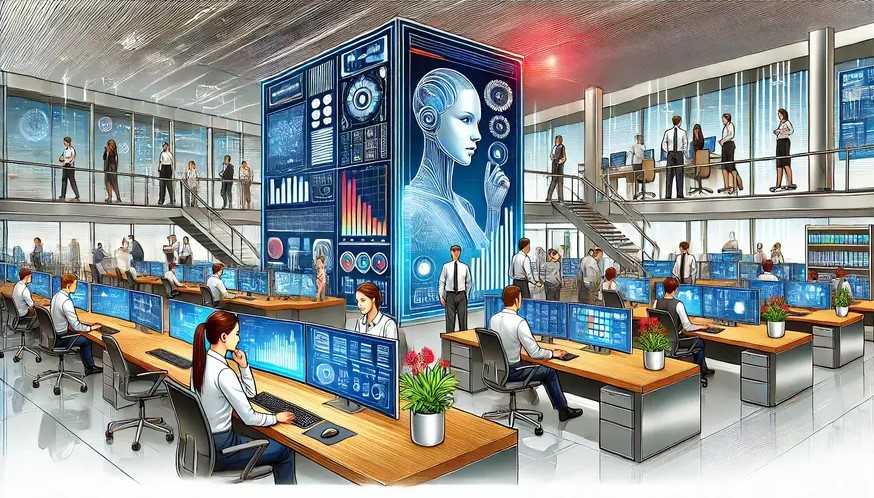How Generative AI is Reshaping Business Models

Generative AI is making waves across various sectors, transforming business models, and opening new avenues for innovation. This technology, known for creating content from data inputs and user prompts, is revolutionizing marketing, operations, IT, and more. Let's dive into how generative AI is reshaping the business landscape, its potential applications, and the necessary precautions for its deployment.
A New Era of Creativity and Interaction
Generative AI revolutionizes how businesses blend human creativity with automated efficiency, driving unprecedented innovation and interaction across various sectors.
Transforming Interaction Labor
Generative AI is pushing further into human realms, particularly in interaction labor, such as customer service. Traditionally, this area experienced limited technological intervention. However, generative AI now undertakes interaction tasks, closely mimicking human behavior. While these tools are not designed to work without human input, they significantly augment human capabilities, making processes faster and more efficient.
Enhancing Creativity
Generative AI leverages vast amounts of data and user prompts to generate entirely new content, venturing into what was once considered a uniquely human domain: creativity. This capability unleashes creativity by providing humans with starter ideas, helping them think outside the box and innovate. This collaboration between AI and humans is fostering a more dynamic and inventive business environment.
Business Applications of Generative AI
Generative AI models are already demonstrating their potential across various business functions. Here are some notable applications:
Marketing and Sales
- Personalized Content Creation: Generative AI crafts customized marketing content, including text, images, and videos, tailored to specific businesses and audiences.
- Social Media and Technical Sales Content: It creates engaging social media posts and detailed technical sales materials, enhancing customer engagement and driving sales.
Operations
- Task Automation: AI-generated task lists streamline activities, improving operational efficiency. By automating routine tasks, businesses can focus on strategic initiatives that drive growth.
IT and Engineering
- Code Generation and Documentation: Generative AI writes, documents, and reviews code, reducing development time and improving accuracy. This results in faster product launches and more reliable software.
Risk and Legal
- Complex Query Resolution: AI answers complex legal questions by pulling information from vast legal databases, providing precise and timely responses.
- Document Drafting: It drafts and reviews annual reports, ensuring compliance and accuracy, which helps in maintaining regulatory standards.
Research and Development
- Accelerating Drug Discovery: Generative AI aids in understanding diseases and discovering new chemical structures, speeding up the drug development process. This can lead to quicker delivery of new medications to the market, potentially saving lives.
Benefits and Cautions
While the potential of generative AI is awe-inspiring, it is crucial to approach its deployment with caution due to several challenges.
Accuracy Issues
Generative AI can sometimes produce inaccurate information, a phenomenon known as "hallucination." For example, it might generate incorrect facts in a biography, leading to misinformation. Businesses must implement checks and balances to verify AI-generated content.
Inadequate Filters
Current filters might not effectively catch inappropriate content. For instance, users of an image-generating application received inappropriate avatars despite inputting appropriate photos. Ensuring robust filtering mechanisms is essential to maintain the integrity of AI outputs.
Systemic Biases
Generative AI systems might perpetuate unwanted biases present in the training data. Correcting these biases is crucial to maintaining fairness and accuracy. Companies must work to identify and mitigate biases in AI models to avoid reinforcing societal inequalities.
Intellectual Property Concerns
There are ongoing debates about intellectual property rights related to AI-generated content. Questions arise about who owns a product design or idea created by AI. Clear guidelines and policies must be established to address these concerns and protect intellectual property rights.
Implementing Generative AI in Business
Executives considering generative AI should quickly identify areas where the technology can have the most immediate impact. Here are some initial steps:
Cross-functional Teams
Assemble a team of data scientists, legal experts, and business leaders to address key questions:
- Technology Impact: Where might generative AI aid or disrupt the industry or business value chain?
- Policies and Posture: What stance should the company take towards AI adoption—cautious observation, pilot investments, or building new business models?
- Use Case Selection: Given the limitations of generative AI, what criteria should guide the selection of target use cases?
- Ecosystem Development: How to build an effective ecosystem of partners, communities, and platforms?
Encouraging Innovation
Promote thoughtful innovation with guardrails and sandboxed environments for experimentation. Cloud-based solutions can provide these environments, making it easier for companies to innovate safely. By fostering a culture of innovation, businesses can continuously explore new applications and benefits of generative AI.
Future Ahead
Generative AI is set to revolutionize business models by enhancing creativity, automating tasks, and improving efficiency across various functions. However, its deployment requires mindful planning and attention to accuracy, as well as ethical and legal considerations. By taking a strategic and cautious approach, businesses can harness the full potential of generative AI, driving growth and innovation.
Embracing generative AI can be a game-changer for businesses looking to scale digitally and achieve revenue growth. The key lies in balancing excitement with caution, ensuring this powerful technology is used responsibly and effectively. As companies continue to explore and integrate generative AI, they must remain vigilant in addressing its challenges while capitalizing on its transformative potential.
Looking to dive deeper into the world of Generative AI? Explore our latest posts:
Click to learn more and stay ahead in the AI revolution!




